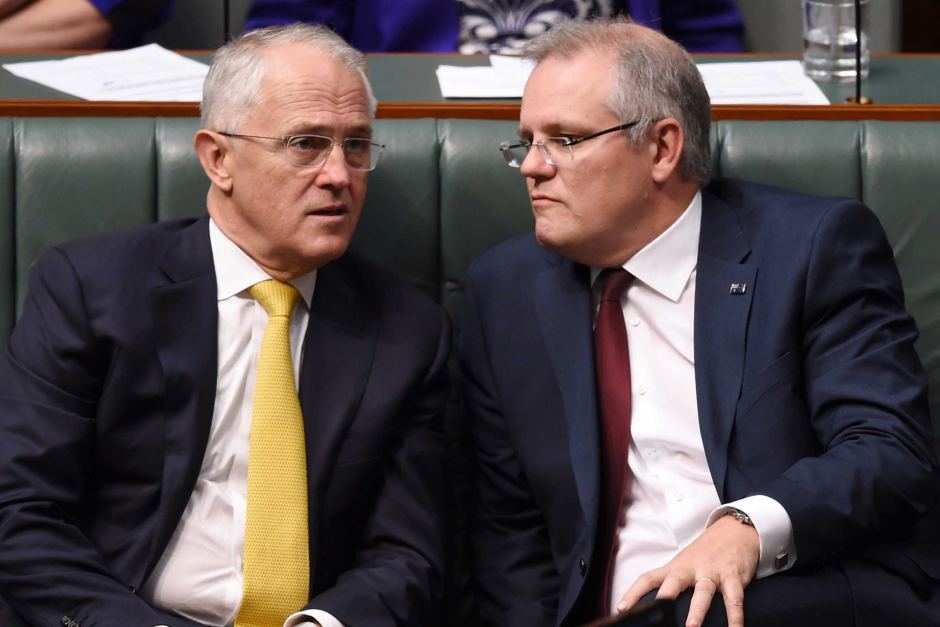Category: Tax / Foreign Affairs / Agreements and Treaties / Stockmarket / Federal Elections
Turnbull's tax plan will 'deliver multi-billion-dollar gift to US Treasury'
Monday, 16 May 2016 06:28:33 | Stephen Long

Australian Prime Minister Malcolm Turnbull (left) speaks to Federal Treasurer Scott Morrison during House of Representatives Question Time at Parliament House in Canberra, Wednesday, February 10, 2016. (AAP: Lukas Coch)
The Turnbull Government's planned company tax cuts would slash Australian revenue while delivering a multi-billion-dollar tax windfall to the US Treasury, new research says.
Key points:
- Planned cut will transfer over $11 billion revenue from Australian to US
- Government argument for cut is to attract more foreign investment
- Mr Oquist says under treaty US companies pay difference to US Treasury
- On current exchange rate it would mean $AU11 billion in revenue foregone
The US company tax rate is 35 per cent, while Australia's is 30 per cent. Under a tax treaty, American companies paying tax in Australia would have to make up the difference at home.
Using data from the US Internal Revenue Service, research by the Australia Institute found the planned company tax cut outlined in this month's budget would transfer more than $11 billion in revenue from Australian to US coffers.
The main argument for the Turnbull Government's proposal to cut the company tax rate to 25 per cent over the next 10 years has been that it would attract more foreign investment — producing a bigger, more productive economy in the long run.
US companies are by far the biggest source of direct foreign investment in Australia.
"So in a sense what you've got is a tax transfer from the Australian ATO to the Internal Revenue Service (IRS) of the United States," the Australia Institute's executive director Ben Oquist said.
He argues that Australia's lower company tax rate was effectively a gift to the US, allowing its tax office to collect more revenue at Australia's expense.
And if the company tax rate is cut lower, the size of the gift will grow.
"Once the company tax cut as proposed comes into full operation in 2026-27, we estimate that that extra transfer that will essentially go from the ATO to the US Internal Revenue Service, the annual rate is approximately $US732 million or around $US8 billion over 10 years," Mr Oquist said.
On the current exchange rate that would mean that $11 billion in revenue is foregone.
"I think that Australians will be mightily disturbed to think that they're going to lose some of the revenue from a company tax cut to US taxpayers at their expense, for no economic benefit," Mr Oquist said.
"If that US company is essentially paying the tax but just to somebody else, there can be no extra foreign investment as a result of that."
Mr Oquist said the Government's argument was that the revenue loss would be offset by the possibility of more foreign investment from other jurisdictions due to the lower company tax rate in Australia.
"The reality is of course foreign investment comes to Australia for all sorts of different reasons," he added.
"Whether there's a good education system, whether there's a good infrastructure, whether there's a stable democracy — these are much bigger determinants of investment than the corporate or company tax rate."
Responding to the Australia Institute's report, Finance Minister Mathias Cormann said then-Treasury secretary Ken Henry's tax review, released in 2010, found employment and the economy would benefit from lower company taxes.
"A more competitive company tax rate will attract additional investment, it will boost productivity, it will increase the size of the economy permanently by more than 1 per cent in the long term," Senator Cormann told reporters.
"It will lead to more jobs, it will lead to higher real wages over time and, of course, it will lead to additional revenue for Government over time which will help underpin additional investments in schools, hospitals, roads and so on."
At a Senate estimates hearing on the week of the budget, Treasury forecast that the Government's corporate tax cut and key related measures would cost more than $48 billion in revenue forgone over 10 years.
On two of three scenarios modelled by Treasury for funding the tax cut, the employment gain over the long term is 0.1 per cent; on the third it is 0.4 per cent.
- About Us
- |
- Terms of Use
- |
-
 RSS
RSS - |
- Privacy Policy
- |
- Contact Us
- |
- Shanghai Call Center: 962288
- |
- Tip-off hotline: 52920043
- 沪ICP证:沪ICP备05050403号-1
- |
- 互联网新闻信息服务许可证:31120180004
- |
- 网络视听许可证:0909346
- |
- 广播电视节目制作许可证:沪字第354号
- |
- 增值电信业务经营许可证:沪B2-20120012
Copyright © 1999- Shanghai Daily. All rights reserved.Preferably viewed with Internet Explorer 8 or newer browsers.




 Send to Kindle
Send to Kindle